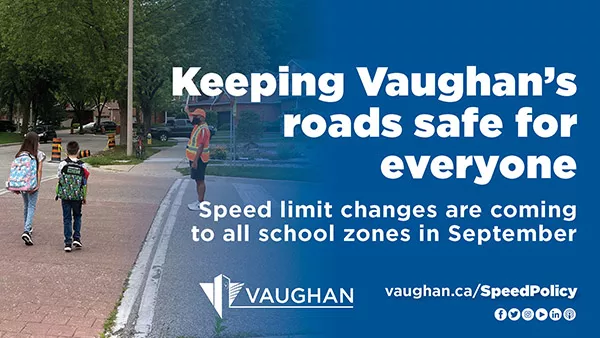Keeping Vaughan’s roads safe for everyone
Speed limit changes are coming to all school zones in September
As children prepare to head back to class soon, safety and effective traffic management remain a top priority for the City of Vaughan. To help ensure families can safely walk, cycle or drive to and from schools, the City is launching the new Speed Limit Policy this September in all school zones across Vaughan.
As children prepare to head back to class soon, safety and effective traffic management remain a top priority for the City of Vaughan. To help ensure families can safely walk, cycle or drive to and from schools, the City is launching the new Speed Limit Policy this September in all school zones across Vaughan.
Speed limits in school zone areas will decrease from 50 to 40 kilometres per hour. New signage is currently being installed in all these areas throughout Vaughan to remind citizens of the reduced speed limits and is anticipated to be completed by Sept. 8, 2021. The City has compiled a list of all the affected school zones (PDF).
Approved by Council on June 2, 2021 (PDF), the policy sets and adjusts appropriate speed limits throughout the City’s street network to continue to ensure a safe community for all road users and address growing urbanization as more cars are anticipated to be on the roads. The policy is exclusive to municipal roads and focuses on four areas within Vaughan’s road network: rural roadways, built-up/urban areas (including school zones), public laneways and select neighbourhoods. Evidence suggests that lowering speed limits, especially in residential areas, can be effective in reducing the risk of severe injury or even death due to a motor vehicle accident.
When students head back to class in September, there will be more pedestrian and vehicular traffic on the roads. It’s important for children, parents and drivers to be alert, follow the rules of the road and walk safely – especially in school zones. Take extra precautions around crosswalks, pedestrian crossovers, stopped school buses, schools and intersections.
Tips for all pedestrians:
- Be mindful of slippery conditions on sidewalks and roadways.
- Walk young children to school.
- Encourage children to always obey crossing guards.
- Walk, don’t run, when crossing the street.
- Pay attention to vehicular traffic while walking along or crossing roads.
- Always obey all traffic rules and signals.
- Ensure you are visible to drivers and cyclists, and make eye contact once they have stopped before crossing.
- Cross at designated crosswalks, crossovers or controlled intersections only.
Tips for drivers and cyclists:
- Reduce speed in school zones, especially when slippery conditions are present, and be ready to stop at all times.
- Expect the unexpected. Children may cross the street at the wrong place, run into oncoming traffic or ride a bike in front of a vehicle without warning.
- Stop for school buses and be aware of children running in front of or behind buses.
- Avoid U-turns in school zones.
- Do not pass other vehicles in a school zone.
- Obey the rules of the road, including posted speed limits.
- Abide by all parking and traffic regulations in school zones.
- Obey crossing guard signals and yield to pedestrians.
- Pay attention to surroundings. Watch for, stop and yield the whole roadway to pedestrians when approaching a pedestrian crossover. (Failing to do so may result in fines from York Regional Police of up to $1,000 and four demerit points.)
- Avoid distractions within the vehicle and ensure children are secured in a correctly installed child restraint seat if required.
- Ensure children exit by the passenger side of the vehicle.
- Keep fire routes and bus zones clear.
- Leave nine metres (or 29 feet) between the car and the crosswalks and/or stop signs when parking. Parking too close to these locations makes it difficult to see children when crossing the road.
- Avoid double parking in school zones.
- Watch for signs indicating “No Stopping” and “No Parking.”
- Stay back 0.6 metres (or two feet) from private driveways to avoid upsetting residents.
School zone safety continues to be a joint priority for the City’s Transportation and Fleet Management Services, By-law and Compliance, Licensing and Permit Services and Vaughan Fire and Rescue Service departments. Together with York Regional Police, York Region, York Region District School Board and York Catholic District School Board, the City continues working to ensure the safety of all members of the community.
As well, schools throughout York Region are encouraging students and their families to use active means of travel to school such as walking or biking instead of driving. Active School Travel programs promote increased physical activity, manage traffic congestion and improve air quality. Parents can learn more through their children's schools or by visiting vaughan.ca/SchoolZoneSafety.
Vaughan’s Speed Limit Policy is part of one of four programs in the City’s MoveSmart Mobility Management Strategy (2022-2026), which focuses on road safety and citizen engagement. MoveSmart sets the direction and priorities for the next five years while ensuring an efficient, reliable, safe and sustainable transportation system for everyone that works, lives in or visits Vaughan.
On March 10, 2021, Council endorsed MoveSmart, reinforcing the City’s commitment to Transportation and Mobility – a strategic priority in the 2018-2022 Term of Council Service Excellence Strategic Plan. It focuses on improving the municipal road network, enhancing road safety and supporting more cycling and pedestrian infrastructure to create fully connected and integrated communities. The strategy will be reviewed and updated every five years. Progress on its implementation will be reported annually to Council. For more information, visit vaughan.ca/MoveSmart.
To receive Vaughan’s latest updates as they happen, sign up for the City Update eNewsletter at vaughan.ca/CityUpdate and follow the City’s Twitter, Facebook, Instagram and LinkedIn channels.
-30-

